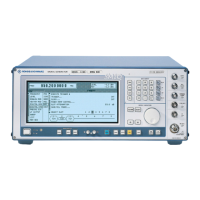SMIQ Bit Error Rate Test
1125.5555.03 2.377 E-9
Possible Problems with BER Measurement and Related Solutions
Fault Possible cause Fault description/remedy
No signals received from
DUT or the signal level is
not correct.
Ø Check displays for activity at BER measurement inputs.
If a status is displayed (Clock, Data, Sync) for a line, there is
activity.
The selected PRBS is not
correct.
Normally, the PRBS on which the data are based is used as the
default setting. If the PRBS is changed, the BER measurement
cannot synchronize to the data (because the polynomial is not
correct).
A wrong clock edge is
used, which violates setup
or hold times.
Ø Check the bit clock signal, the data signal and the data enable
signal, if any, on an oscilloscope.
The fault may also be caused by reflections on the clock line, which
switch the data signal twice into the BER measurement, eg on lines
without termination. The SMIQ input is not terminated.
Incorrect polarity of data
signal (or data enable
signal).
In this case the PRBS cannot synchronize. Note that an inversion
of the output signal specified for some cases by the PRBS
standard is performed automatically upon PRBS selection.
Manual inversion of the data signal is therefore not required.
BER
measurement
does not
synchronize
A bit error occurs during
synchronization (nine data
bits with PRBS9)
The BER measurement is started at a wrong position so that
about 50% of the subsequent data bits are identified as faulty.
No clock received
from DUT
When testing RF
components, clock
recovery is not available.
An external clock is
however required for
clocking the data during the
BER measurement
Instead of a clock recovery circuit, the bit clock at the PAR-DATA
connector of the SMIQ may be possibly used as a replacement.
This is possible if DGEN (SMIQB11) is used as a data source.
However, this bit clock is not possible with all modulation types.
Also, the delay between data and clock has to be observed.
Measured BER
too high
The data are clocked with
the wrong edge and/or the
eye aperture of the data is
not optimally met.
Ø Check the clock/data relationship by means of an oscilloscope and
set optimum timing.
.
BER measurement does
not synchronize
If data that are not cyclically continued (ie when a break occurs at the
memory wrap-around), the measurement will identify about 50% of the
bits as faulty after the wrap-around.
Make sure the measurement is started optimally at the beginning of the
sequence by means of a signal on the REStart line (see: "BER
measurement with interrupted random sequence – integrating BER
measurement" in section 2.23.1.3, "Test Method").

